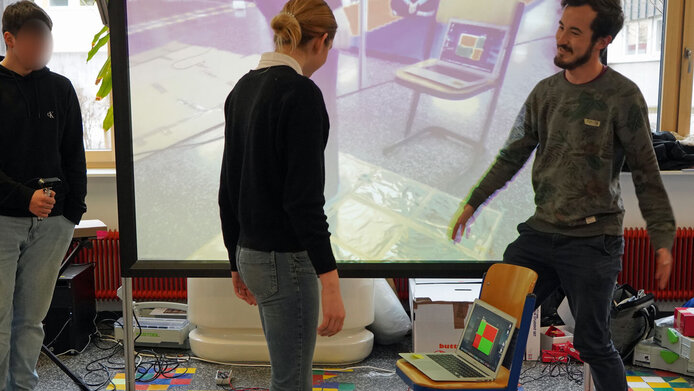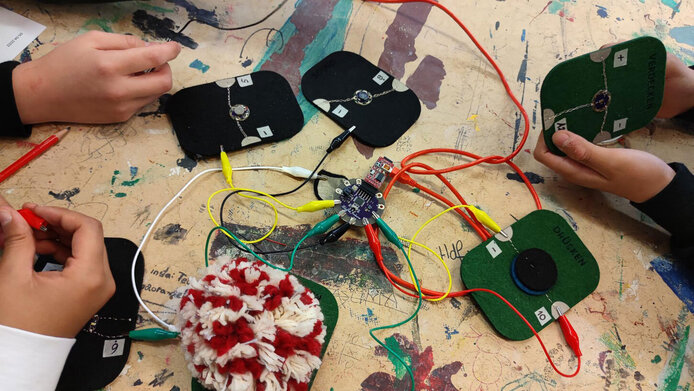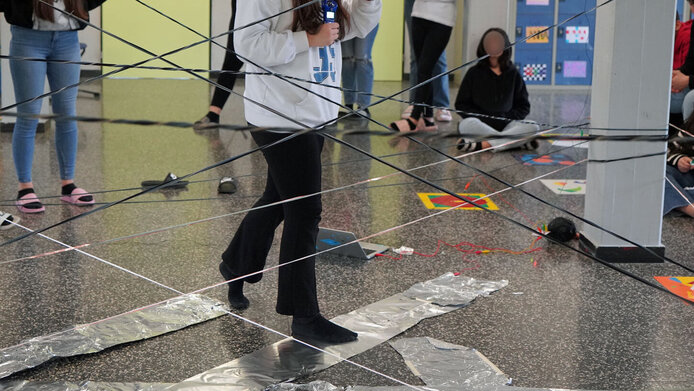Interactive technologies for being different together

“Technologies have the power to assign social categories by dividing people into groups on the basis of gender, age or origin. This results in exclusion. Diversity computing is a critical investigation of this power and intends to envision new concepts for inclusive and diverse technologies.” This is how Christopher Frauenberger, professor at the University of Salzburg’s Center for Human-Computer Interaction (HCI) sums up his research field. Together with postdoc Jeanette Falk and PhD students Anna Blumenkranz and Moritz Kubesch, Frauenberger is working on the FWF-funded Diversity Computing Spaces project, which explores how digital technologies can be used to create intelligent physical spaces for very different groups of people, where they can experience things together without feeling excluded. For this purpose, Frauenberger's team is working with second-grade teachers and students at a Salzburg secondary school.
Understanding diversity
In order to capture the diversity of the students and incorporate it in the implementation of the Diversity Computing Spaces, the research team held nine workshops for two school classes each in 2022. “It is particularly important to take all dimensions of diversity seriously. This relates to more than categories such as gender or age and can also include aspects such as moods and experiences. We want to incorporate the students' contributions in our research by using participatory design methods,” explains Jeanette Falk.
The researchers explored how students perceive informal spaces such as break rooms or schoolyards and then involved them in possible redesigns of these spaces using mainly interactive technologies. The youngsters' ideas covered a wide range, from massage robots to entertainment systems or spaces for pursuing their interests – without any special technologies. The students coded some aspects of their ideas by means of easy-to-use computers such as Calliope mini, Makey-Makey, and e-textiles with Arduino controllers, and developed simple prototypes. In the process, the researchers collected feedback and produced photos, audio and video recordings that were evaluated together with the notes made by workshop leaders.
Making spaces your own and experiencing conflict
“The students displayed a complex understanding of technology and how it could help or limit them in social spaces,” explains Falk. Apart from being aware of useful functions such as entertainment and personal comfort, the young people also knew that they might be monitored by cameras and thus restricted in using certain spaces freely. This appropriation of spaces was also a central theme in the evaluation. Appropriation is important because it happens all the time, both individually and collectively. It involves young people taking space from and giving it to one another and deciding who is supposed or allowed to do what and where, or not.
“The sofas in the hallway or in the library were important venues of social interaction, but also of individual retreat,” notes Frauenberger, who speaks about the practice of “place-making”. “The process also resulted in conflicts between the youngsters – sometimes willfully, but also involuntary. Willful playful conflicts, minor disputes or scuffles, can be educational social interactions, but involuntary conflicts create stress.” The students also attributed great importance to the ways in which they can affirm their membership in groups, but also their individuality, and how to convey it to others. These themes led the researchers to three design directions that they implemented in the subsequent stages of the project.
Retreats, asymmetrical design and creative AI
“How can we use technology to design spaces in schools where young people can withdraw without creating unwanted conflicts?” was a question that prompted one of the three design directions. The team also explored ideas on how willful and playful conflicts could be promoted through asymmetric digital game design in order to accommodate the diverse skills of students in coping with such conflicts.
The third design route related to activity spaces, enabling the young people to be seen by their peers in order to affirm group membership but also to display individuality. “In this context, a system based on artificial intelligence could help fuel the students’ creativity while deepening their understanding of this technology,” adds Falk.
Frauenberger describes the next stages of the project: “In February 2023, we conducted further workshops. We set up two installations in the school based on our findings and let the students interact with them. On this basis we would like to derive designs for permanent installations that we would intend to implement in the school this fall, which will make it possible for our project to have a long-term effect.”
Personal details
Christopher Frauenberger is a professor at the Center for Human-Computer Interaction at the University of Salzburg. His research focuses on people and digital technologies. Specifically, he uses participatory design approaches to create intentional, technological futures for diverse groups of people in real-world contexts. Groups he worked with include autistic children in schools (SocialPlayTechnologies) or elderly people in smart homes. Together with postdoc Jeanette Falk and PhD students Anna Blumenkranz and Moritz Kubesch, Frauenberger is conducting the Diversity Computing Spaces project. Set to run from 2021 to 2024, the project has been awarded ca. EUR 500,000 in funding by the Austrian Science Fund FWF.
Publications
Falk J., Kubesch M., Blumenkranz A., Frauenberger C.: Three Design Directions for a Diversity Computing Design Space, in: Proceedings of the 2023 CHI Conference on Human Factors in Computing Systems (CHI '23), Association for Computing Machinery, Article 89, 1–16, 2023
Fletcher-Watson, S., De Jaegher, H., van Dijk, J., Frauenberger, C., Magnée, M., & Ye, J. Diversity Computing, in: Interactions, 25(5), 28–33. 2018







